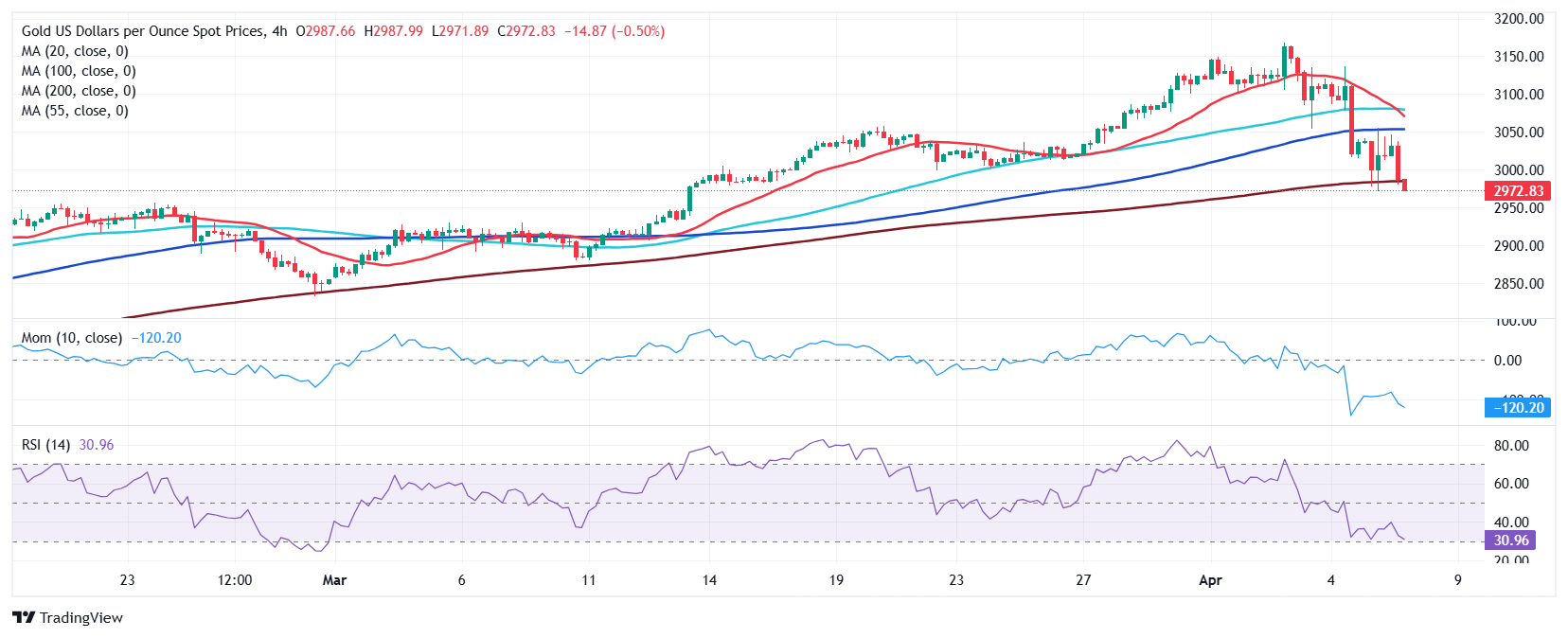XAU/USD Current price: $2,972.83
- Global indexes plunged amid tit-for-tat retaliatory levies between Washington and Beijing.
- The US Dollar found temporary footing on risk aversion, gains limited by recession fears.
- XAU/USD pressures intraday lows and seems poised to extend its slide.

Spot Gold trades in the $2,970 region, approaching the intraday low posted during the Asian session at $2,971.28. Financial markets have been on their toes ever since the day started amid the escalation of the trade war unleashed by United States (US) President Donald Trump last week.
Despite comments about being willing to negotiate retaliatory tariffs announced last Wednesday, Trump decided to lift the bet and pledged additional 50% tariffs on China if Beijing does not back off on the 34% retaliatory levies announced over the weekend.
Chinese announcement sent Asian indexes into a selling spiral, which continued during European trading hours. All indexes closed in the red and with sharp losses, while Wall Street futures also fell. By the time being, indexes managed to bounce from their intraday lows, but are consolidating losses.
In the meantime, rumors of a potential 90-day delay on the implementation of reciprocal tariffs lifted the mood early in the American session, yet hopes were short-lived, as the White House quickly denied such a possibility. Trump, however, repeated on Truth Social that negotiations with “other countries” will take place “immediately.”
Tariff-related developments will dominate the scene during the upcoming days, alongside the trend of all assets. At the time being, the US Dollar (USD) finds risk-related demand, but that may change, considering the ultimate fear is that tariffs will result in higher inflation alongside an economic recession. Markets foresee a gloomy future for the USA, which will impact all other major economies.
XAU/USD short-term technical outlook
From a technical point of view, XAU/USD is poised to extend its slide. The daily chart shows that the pair is developing below its 20 Simple Moving Average (SMA), which now acts as dynamic resistance at around $3,033.60. The 100 and 200 SMAs keep heading north far below the current level, yet technical indicators head south vertically and within negative levels, anticipating another leg south.
In the near term, and according to the 4-hour chart, the bearish case is even clearer. The 20 SMA turned sharply lower, still holding above the 100 and 200 SMAs, which, anyway, lost their bullish strength. The XAU/USD pair is currently piercing its 200 SMA a handful of $ above the current level, while technical indicators resumed their slides after barely correcting early oversold conditions. Immediate support comes at around 2,959.00, where the pair topped late in February. A clear break lower opens the door for a steeper Gold slide.
Support levels: 2,959.00 2,942.50 2,929.45
Resistance levels: 2,982.20 2,998.30 3,015.55
US-China Trade War FAQs
Generally speaking, a trade war is an economic conflict between two or more countries due to extreme protectionism on one end. It implies the creation of trade barriers, such as tariffs, which result in counter-barriers, escalating import costs, and hence the cost of living.
An economic conflict between the United States (US) and China began early in 2018, when President Donald Trump set trade barriers on China, claiming unfair commercial practices and intellectual property theft from the Asian giant. China took retaliatory action, imposing tariffs on multiple US goods, such as automobiles and soybeans. Tensions escalated until the two countries signed the US-China Phase One trade deal in January 2020. The agreement required structural reforms and other changes to China’s economic and trade regime and pretended to restore stability and trust between the two nations. However, the Coronavirus pandemic took the focus out of the conflict. Yet, it is worth mentioning that President Joe Biden, who took office after Trump, kept tariffs in place and even added some additional levies.
The return of Donald Trump to the White House as the 47th US President has sparked a fresh wave of tensions between the two countries. During the 2024 election campaign, Trump pledged to impose 60% tariffs on China once he returned to office, which he did on January 20, 2025. With Trump back, the US-China trade war is meant to resume where it was left, with tit-for-tat policies affecting the global economic landscape amid disruptions in global supply chains, resulting in a reduction in spending, particularly investment, and directly feeding into the Consumer Price Index inflation.
Information on these pages contains forward-looking statements that involve risks and uncertainties. Markets and instruments profiled on this page are for informational purposes only and should not in any way come across as a recommendation to buy or sell in these assets. You should do your own thorough research before making any investment decisions. FXStreet does not in any way guarantee that this information is free from mistakes, errors, or material misstatements. It also does not guarantee that this information is of a timely nature. Investing in Open Markets involves a great deal of risk, including the loss of all or a portion of your investment, as well as emotional distress. All risks, losses and costs associated with investing, including total loss of principal, are your responsibility. The views and opinions expressed in this article are those of the authors and do not necessarily reflect the official policy or position of FXStreet nor its advertisers. The author will not be held responsible for information that is found at the end of links posted on this page.
If not otherwise explicitly mentioned in the body of the article, at the time of writing, the author has no position in any stock mentioned in this article and no business relationship with any company mentioned. The author has not received compensation for writing this article, other than from FXStreet.
FXStreet and the author do not provide personalized recommendations. The author makes no representations as to the accuracy, completeness, or suitability of this information. FXStreet and the author will not be liable for any errors, omissions or any losses, injuries or damages arising from this information and its display or use. Errors and omissions excepted.
The author and FXStreet are not registered investment advisors and nothing in this article is intended to be investment advice.
Recommended Content
Editors’ Picks

AUD/USD holds lower ground near 0.6350 after downbeat Aussie jobs data
AUD/USD is holding lower ground near 0.6350 in Asian trading on Thursday. The downbeat Australian jobs data fans RBA rate cut bets, maintaining the downward pressure on the pair. US-China trade tensions and US Dollar recovery act as a headwind for the pair.

USD/JPY fades the rebound to 142.85 amid US-Japan trade optimism
USD/JPY fades the impressive rebound from seven-month lows of 141.61, falling back toward 142.00 in the Asian session on Thursday. The pair tracks the US Dollar price action, fuelled by contrstructive trade talks between the US and Japan. A tepid risk recovery supports the pair.

Gold price corrects from record highs of $3,358
Gold price retreats from a fresh all-time peak of $3,358 reached earlier in the Asian session on Thursday. Despite the pullback, tariff uncertainty, the escalating US-China trade war, global recession fears, and expectations of more aggressive Fed easing will likely cishion the Gold price downside.

Ethereum face value-accrual risks due to data availability roadmap
Ethereum declined 1%, trading just below $1,600 in the early Asian session on Thursday, as Binance Research's latest report suggests that the data availability roadmap has been hampering its value accrual.

Future-proofing portfolios: A playbook for tariff and recession risks
It does seem like we will be talking tariffs for a while. And if tariffs stay — in some shape or form — even after negotiations, we’ll likely be talking about recession too. Higher input costs, persistent inflation, and tighter monetary policy are already weighing on global growth.

The Best brokers to trade EUR/USD
SPONSORED Discover the top brokers for trading EUR/USD in 2025. Our list features brokers with competitive spreads, fast execution, and powerful platforms. Whether you're a beginner or an expert, find the right partner to navigate the dynamic Forex market.